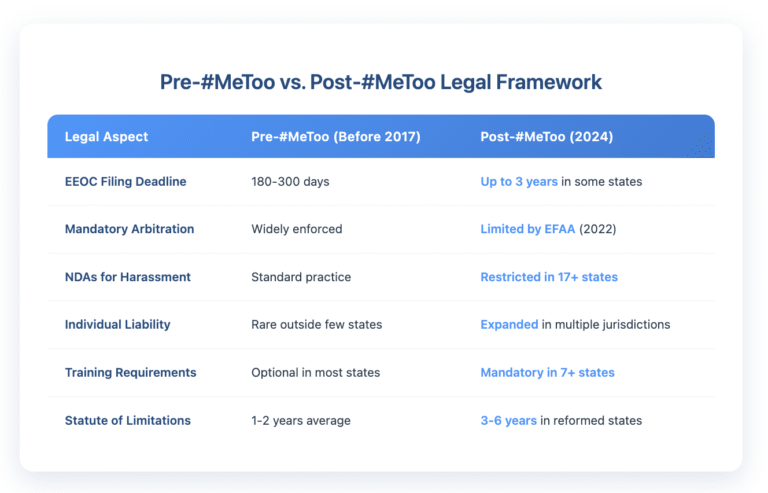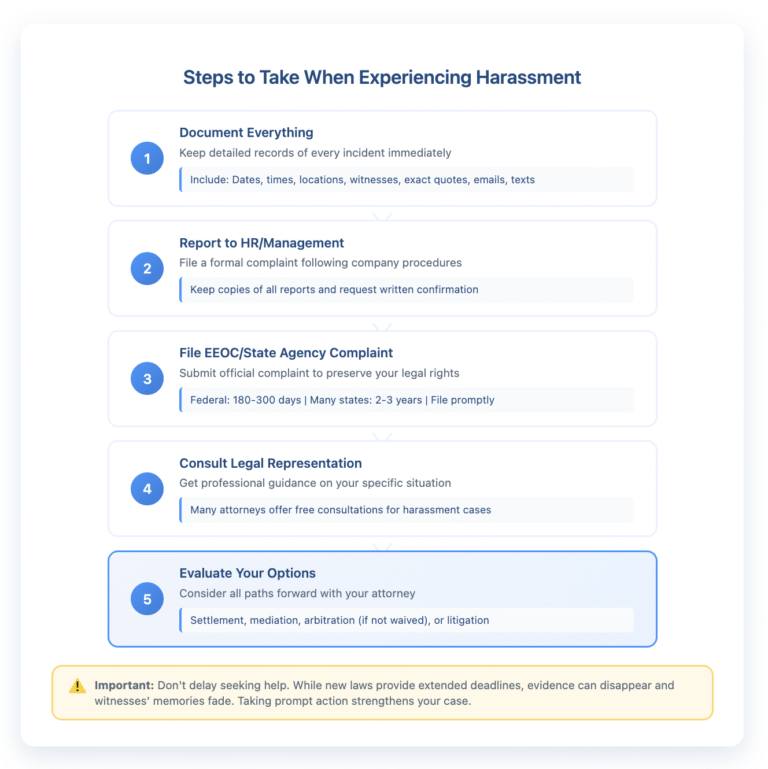If you’re wondering whether the #MeToo movement actually changed workplace harassment laws, the answer is a resounding yes. Since October 2017, when the movement gained global momentum, both federal and state legislatures have passed sweeping reforms that fundamentally altered how harassment claims are handled.
These changes directly affect your rights as an employee. You now have stronger protections, extended filing deadlines, and in many cases, fewer barriers to holding employers accountable for workplace harassment.
Disclaimer: This article provides general information for informational purposes only and should not be considered a substitute for legal advice. It is essential to consult with an experienced employment lawyer at our law firm to discuss the specific facts of your case and understand your legal rights and options. This information does not create an attorney-client relationship.
The Legal Landscape Before #MeToo
Prior to 2017, workplace harassment laws hadn’t seen significant updates in decades. The Civil Rights Act of 1991 was the last major federal reform addressing sexual harassment.
Employees faced substantial obstacles when reporting harassment. Mandatory arbitration clauses prevented 60 million American workers from taking their cases to court. Non-disclosure agreements (NDAs) silenced victims even after settlements were reached.
Key Pre-#MeToo Limitations
The statute of limitations for filing EEOC complaints remained at 180-300 days, depending on the state. This tight timeline often expired before employees felt safe enough to report harassment.
Damage caps under Title VII limited compensatory and punitive damages based on employer size. For companies with 15-100 employees, the cap was just $50,000. Even for employers with over 500 employees, damages maxed out at $300,000.

Major Federal Changes Since #MeToo
The most significant federal reform came with the Ending Forced Arbitration of Sexual Assault and Sexual Harassment Act (EFAA), signed into law on March 3, 2022. This law invalidates pre-dispute arbitration agreements for sexual harassment and assault claims.
What does this mean for you? If you signed an arbitration agreement when you were hired, you can now choose to pursue sexual harassment claims in court instead of private arbitration.
The Speak Out Act of 2022
Congress passed the Speak Out Act in December 2022, which prevents the enforcement of pre-dispute NDAs in cases involving sexual assault or harassment. This means employers can’t use previously signed confidentiality agreements to prevent you from discussing harassment that occurred.
These federal protections apply retroactively. Even if you signed agreements years ago, they’re no longer enforceable for sexual harassment or assault claims.
State-Level Legal Reforms
States have enacted even more comprehensive reforms than the federal government. New York, California, New Jersey, and Illinois lead the nation in expanding harassment protections.
New York’s Groundbreaking Changes
New York eliminated the “severe or pervasive” standard for harassment claims in 2019. Previously, courts required harassment to be extremely serious or frequent to be actionable. Now, any harassment that rises above “petty slights or trivial inconveniences” can form the basis of a claim.
The state also extended its statute of limitations for sexual harassment claims from one year to three years. This change, effective August 2020, gives employees significantly more time to file complaints with the New York State Division of Human Rights.
California’s Comprehensive Approach
California’s Fair Employment and Housing Act (FEHA) now requires employers with five or more employees to provide sexual harassment training. Supervisors need two hours of training every two years, while non-supervisory employees require one hour.
The state also enacted the Silenced No More Act in 2022, which expands NDA restrictions beyond sexual harassment to include all forms of workplace discrimination, harassment, and wrongful termination cases.

How These Changes Affect Your Rights
The legal reforms translate into concrete protections for employees facing harassment. Understanding these changes helps you recognize when your rights have been violated.
Extended Time to File Claims
Many states now provide two to three years to file harassment complaints, compared to the previous one-year limits. This extended timeline recognizes that processing trauma and deciding to report takes time.
The EEOC has also adopted a more flexible approach to filing deadlines when “extraordinary circumstances” prevented timely filing. Courts have recognized ongoing harassment, fear of retaliation, and mental health impacts as potential extraordinary circumstances.
Broader Definition of Actionable Harassment
The elimination of the “severe or pervasive” standard in states like New York means single incidents can now support harassment claims if they’re serious enough. Comments about appearance, unwanted touching, or discriminatory remarks don’t need to occur daily to be legally actionable.
Federal courts are also beginning to adopt more employee-friendly standards. The Second Circuit’s decision in Moll v. Telesector Resources Group (2023) emphasized that harassment should be viewed from the perspective of a reasonable person in the plaintiff’s position.
Employer Accountability Measures
Legal reforms have significantly increased employer responsibilities for preventing and addressing harassment. These changes create stronger incentives for companies to maintain harassment-free workplaces.
Mandatory Training Requirements
Seven states now mandate sexual harassment training for all employees. New York requires annual training for every employee, regardless of company size. Illinois mandates training for bars and restaurants specifically.
These training requirements must meet specific content standards. They must include examples of unlawful harassment, information about federal and state laws, and remedies available to victims.
Individual Liability Expansion
Several states now allow employees to sue individual harassers directly, not just the employer. New York’s Human Rights Law permits individual liability for anyone who “aids, abets, incites, compels or coerces” harassment.
This means supervisors and coworkers who engage in harassment can face personal financial liability. They can’t hide behind corporate protections when they violate harassment laws.

Practical Steps for Protecting Yourself
Knowing your rights is just the first step. Taking action to protect yourself requires understanding the practical aspects of harassment law.
Documentation Is Critical
Keep detailed records of every incident. Include dates, times, locations, witnesses, and exact quotes when possible. Save all electronic communications—emails, texts, instant messages—that show harassment or your efforts to report it.
Create a timeline of events while memories are fresh. Courts give more weight to contemporaneous documentation than recollections made months or years later.
Understanding Retaliation Protections
Retaliation claims often succeed even when underlying harassment claims don’t. The Supreme Court’s decision in Burlington Northern v. White (2006) established that any employer action that would dissuade a reasonable employee from complaining constitutes illegal retaliation.
Post-#MeToo reforms have strengthened these protections. Many states now explicitly protect employees who report harassment from any adverse employment action, including schedule changes, unfavorable assignments, or social isolation.
The Role of Social Media and Public Pressure
The #MeToo movement demonstrated how public pressure can supplement legal action. While defamation laws still apply, courts have become more protective of employees’ rights to discuss workplace conditions publicly.
The National Labor Relations Board has consistently held that employees have the right to discuss workplace harassment on social media as “protected concerted activity.” This protection applies even to non-unionized workplaces.
Balancing Legal Strategy with Public Advocacy
Speaking publicly about harassment can strengthen your position but requires careful consideration. Public statements can affect settlement negotiations and potential litigation.
Any public statements should be factual and avoid speculation about motives or unwitnessed events. Focus on your own experiences rather than making broad accusations about company culture.
Industry-Specific Changes
Certain industries have seen targeted reforms addressing their unique harassment challenges.
Entertainment and Media
The New York State Human Rights Law now explicitly covers freelancers and independent contractors in the entertainment industry. California’s AB 2338 requires entertainment industry employers to provide bystander intervention training.
Hospitality and Service Industries
Several cities, including Chicago and Washington D.C., have enacted ordinances requiring panic buttons for hotel workers. These laws recognize the particular vulnerability of employees working alone in guest rooms.
Technology and Startups
Following high-profile harassment cases in Silicon Valley, California passed SB 1300, which explicitly prohibits employers from requiring harassment claims to be kept confidential as a condition of employment.
What Hasn't Changed
Despite significant progress, some legal barriers remain. Understanding these limitations helps set realistic expectations.
Damage Caps Under Federal Law
Title VII damage caps haven’t increased since 1991, despite inflation significantly eroding their value. A $300,000 cap in 1991 dollars equals roughly $650,000 today, yet the statutory limit remains unchanged.
Some states have higher damage caps or no caps under state law. New York, for example, has no statutory cap on compensatory damages for harassment claims brought under state law.
The Faragher-Ellerth Defense
Employers can still avoid liability if they prove they exercised reasonable care to prevent harassment and the employee unreasonably failed to use available complaint procedures. This defense, established by two 1998 Supreme Court cases, remains intact.
However, courts now scrutinize whether complaint procedures were genuinely accessible and effective. Token policies that exist only on paper won’t protect employers from liability.
Looking Forward: Ongoing Legal Developments
Harassment law continues evolving as courts interpret new statutes and legislatures respond to emerging issues.
The EEOC has proposed new enforcement guidance on harassment for the first time since 1999. The proposed guidance would recognize harassment based on sexual orientation and gender identity as sex discrimination under Title VII.
Several states are considering legislation to eliminate Title VII damage caps for state law claims. New Jersey’s pending bill would remove all caps on compensatory and punitive damages for harassment claims.
Taking Action: Your Next Steps
If you’re experiencing workplace harassment, don’t wait to seek help. The extended statutes of limitations provide more time, but evidence can disappear, and witnesses’ memories fade.
Start documenting incidents immediately. Review your employee handbook and follow reporting procedures while keeping copies of everything. File complaints with both your employer and appropriate government agencies to preserve all legal options.
Consider consulting with an employment attorney early in the process. Many attorneys offer free consultations for harassment cases, and understanding your rights from the start can prevent costly mistakes.
The #MeToo movement created a watershed moment in harassment law, but these legal protections only work when employees understand and assert their rights. The landscape has fundamentally shifted in favor of employees willing to stand up against harassment.
If you’re facing workplace harassment or have questions about your rights under these new legal protections, contact Nisar Law Group for a consultation. Our employment law attorneys stay current on all federal and state harassment law changes to provide you with the strongest possible representation. Don’t let confusion about the law prevent you from seeking justice—reach out today to understand your options and protect your rights.


